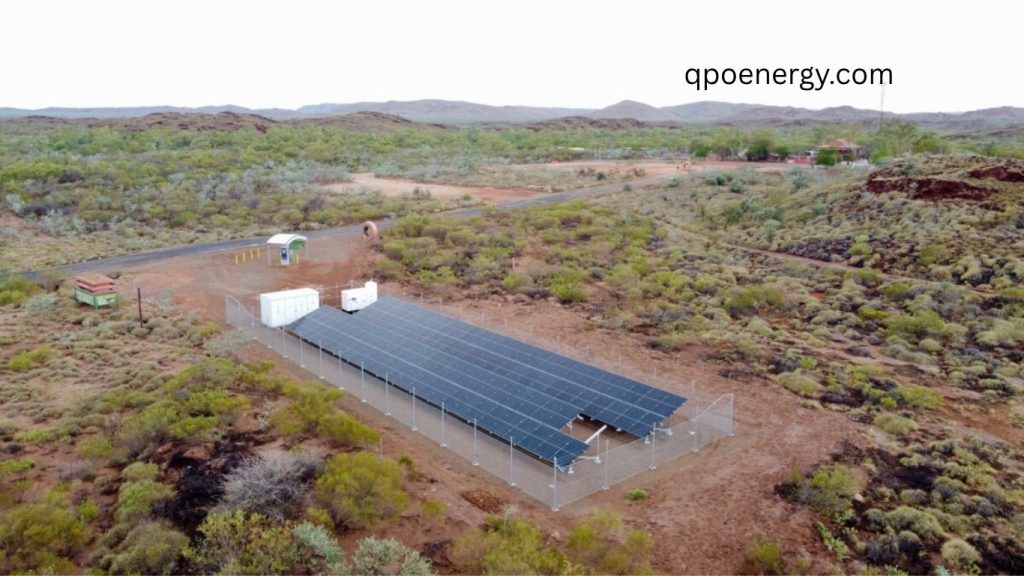In the heart of Western Australia’s rugged Pilbara region, where searing heat and vast distances define daily life, a new chapter in clean energy is unfolding. Karratha-headquartered clean energy company Powerhouse has successfully completed the installation of a 60 kVA off-grid solar array at the Whim Creek Hotel, a historic stop located between Karratha and Port Hedland—1,639 kilometres northeast of Perth.
This pioneering project not only supplies renewable energy to a 50 kW electric vehicle (EV) charging station but also highlights the critical role of solar innovation in bridging remote communities and the state’s growing EV network.
Read More: Empowering Hope: Micro-Hydro Solutions Transform Indigenous Homes in Remote Philippine Villages
Harnessing Solar in the Harsh Pilbara
The newly installed solar system at the Whim Creek Hotel includes high-performance Jinko solar panels, two SMA string inverters to transfer energy to the batteries, and four Victron Quattro inverters designed to discharge stored energy to supply the 50 kW EV charger. With flexibility built into the design, the charger can be upgraded to a 75 kW fast charger, ensuring that drivers are well-prepared for the next stage of Australia’s EV revolution.
Unlike traditional grid connections, this system operates completely off-grid, relying on solar generation and battery storage to deliver reliable charging power in an area where extreme weather and distance from urban centres often limit energy access.
The station forms part of Horizon Power’s Western Australia EV Network, an ambitious rollout of 110 EV fast chargers across 49 regional and remote sites along a 7,000-kilometre stretch of WA roads. This government-backed initiative, supported by gentailers Horizon Power and Synergy, is set to become the longest EV charging network in Australia, ensuring drivers can travel across one of the world’s most isolated regions without fear of being stranded.

Challenges of Building in Remote Australia
Delivering clean energy solutions in one of the harshest climates on Earth is not a straightforward task. The Whim Creek Hotel installation was completed in December 2024, when daytime temperatures in the Pilbara often climbed to nearly 50°C. To cope with the blistering heat, Powerhouse crews worked at night to assemble the 106-panel, 475 W per module system.
Powerhouse founder and co-owner Brigette McDowell explained that such projects require teams to be multi-skilled, as relying on external contractors in remote regions can quickly become financially prohibitive.
“Our team do all the crane lifts, fencing, footings—everything. The Whim Creek site is located in wind region D, which meant additional engineering and strengthening was needed. Working in 48°C heat is extremely challenging, but planning and preparation kept the team safe and efficient,” McDowell said.
Often, teams are required to camp on-site during remote builds. Fortunately, for this project, the crew was able to stay at a nearby mining facility, providing some relief from the punishing conditions.
The Power of Preparation
For McDowell, the key to safe and successful installations lies in meticulous organisation and foresight. Remote builds leave no margin for error.
“If you forget one clamp, you will blow your budget and your timeframe,” she emphasized.
This philosophy underscores the importance of logistics, planning, and execution in delivering projects in areas where spare parts, tools, or additional materials cannot be sourced easily. Each detail, from transport routes to structural reinforcements, must be carefully accounted for before work begins.
Expanding the WA EV Network
The Whim Creek Hotel project is not an isolated achievement. Following its completion, Powerhouse went on to commission another EV charger at the Mundrabilla Roadhouse on the Nullarbor, located 1,361 kilometres east of Perth. With these additions, Powerhouse has now delivered 12 EV chargers for the WA EV Network.
The broader EV rollout is a landmark initiative for Western Australia. With over 7,000 kilometres of connected roads, the network will provide confidence to EV drivers traveling across some of the most isolated stretches of highway in the world.
For regional towns and roadside stops, these chargers represent more than just energy infrastructure. They are lifelines for tourism, local economies, and sustainable travel, helping businesses attract visitors who might otherwise bypass these remote locations.

Why Remote Solar Arrays Matter
Australia’s EV adoption has grown rapidly in recent years, but the vastness of regional WA poses unique challenges. Unlike metropolitan areas where chargers can be connected to the grid with relative ease, towns in the Pilbara, Gascoyne, or Nullarbor often rely on diesel generators or limited energy resources.
By deploying off-grid solar arrays, companies like Powerhouse are creating self-sustaining energy hubs that not only power EVs but also reduce carbon emissions, cut reliance on diesel, and improve resilience in remote areas.
These systems also future-proof the region. As EV uptake increases, demand for faster, higher-capacity chargers will rise. By designing modular systems that can be scaled up, Powerhouse ensures that installations like Whim Creek remain relevant for years to come.
The Broader Energy Transition
Western Australia’s investment in renewable-powered EV infrastructure forms part of its broader strategy to decarbonize transport and energy sectors. The WA EV Network complements other state-led initiatives, such as renewable microgrids, hydrogen pilots, and battery storage projects that aim to transform how regional communities generate and consume power.
For the government, the EV Network is both a climate commitment and an economic enabler, supporting local businesses, creating jobs, and opening the door for eco-tourism across WA’s iconic landscapes.
For Powerhouse, projects like Whim Creek demonstrate that small, agile clean energy companies play a vital role in delivering innovation where larger players may hesitate due to cost or complexity.
Frequently Asked Questions:
Where is the Whim Creek Hotel located?
The Whim Creek Hotel is situated between Karratha and Port Hedland in Western Australia’s Pilbara region, approximately 1,639 kilometres northeast of Perth.
Who completed the solar installation at Whim Creek Hotel?
Karratha-based clean energy company Powerhouse completed the 60 kVA off-grid solar array installation.
What makes this solar array unique?
The system operates entirely off-grid, using Jinko panels, SMA string inverters, and Victron Quattro inverters to power a 50 kW EV charger, upgradeable to 75 kW.
How does this project fit into Western Australia’s EV Network?
The Whim Creek EV charger is part of Horizon Power’s Western Australia EV Network, which will cover more than 7,000 kilometres with 110 fast chargers across 49 sites.
What challenges did Powerhouse face during the installation?
Crews worked in extreme December heat nearing 50°C, requiring night shifts, additional wind-region engineering, and self-sufficient logistics to complete the project.
How many EV chargers has Powerhouse installed for the WA EV Network?
With the Whim Creek and Mundrabilla Roadhouse projects, Powerhouse has delivered 12 EV chargers for the network.
Why is solar important for remote EV charging stations?
Solar-powered systems reduce reliance on diesel generators, lower emissions, and provide reliable, self-sustaining power in remote areas where grid connections are impractical.
Conclusion
The installation of the solar-powered EV charger at the historic Whim Creek Hotel marks a milestone in Australia’s clean energy transition. By overcoming extreme Pilbara conditions and logistical challenges, Powerhouse has demonstrated that renewable innovation can thrive even in the country’s most remote regions. As part of Western Australia’s 7,000-kilometre EV Network, this project not only supports sustainable transport but also strengthens regional communities, boosts tourism, and reduces reliance on fossil fuels. The Whim Creek charger is more than infrastructure—it is a symbol of resilience, progress, and the future of clean mobility across Australia’s vast landscape.


